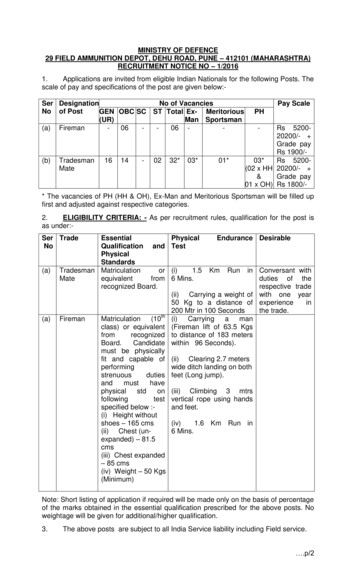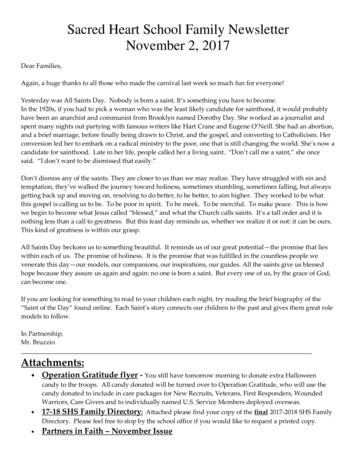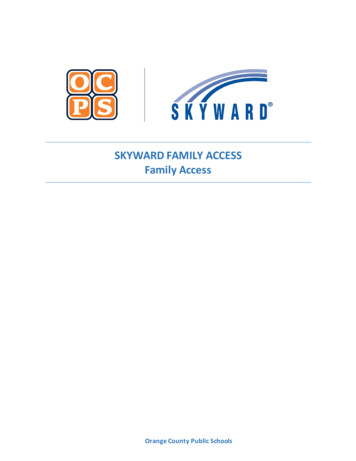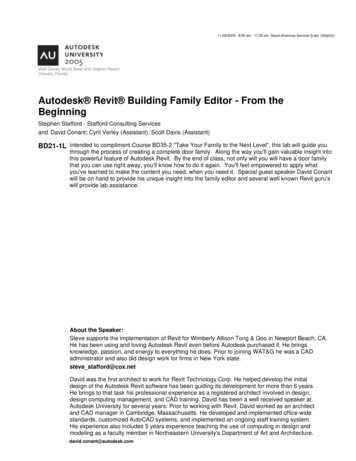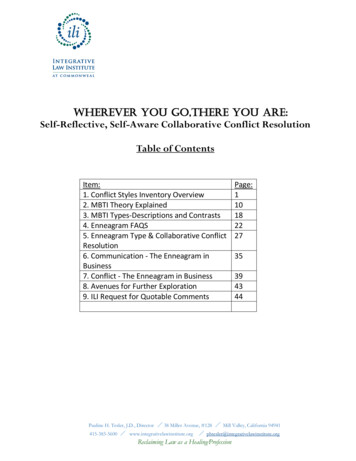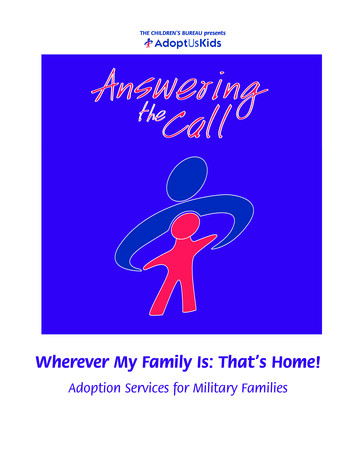
Transcription
THE CHILDREN’S BUREAU presentsWherever My Family Is: That’s Home!Adoption Services for Military Families
The Color Purple In military jargon “purple” refers to an issue or operation that includesall uniformed services – Army, Navy, Air Force, Marine and CoastGuard. Purple is what you get when you mix the greens, blues andkhakis of the various uniforms. In today's military climate, the serviceswork jointly in many instances, overcoming hurdles en route to theirgoal. In the same way, adoption professionals and military families canbe “purple” as they work towards the common goal of providing greatfamilies for waiting children.Special AcknowledgementsThe Families – we wish to thank the military families who so generously contributed their time and stories to this Guide –George and Cecilia GreeneJan and Jenny JanuaryJohn LeavittJim and Gail McCloudJim and Karen PottsWe wish you and your families the best that life has to offer.The Social Workers – we encountered some very dedicated social workers in our journey. Our heartfeltthanks to:Margaret Linnemann, MSW, LCSW, Foster Care Program Manager, State of OklahomaRobin Gibson, BSW, Adoption Specialist, State of OklahomaRobin Preusser, VIDA, Voice for International Development and AdoptionYour commitment is truly admirable!The Practitioners – we also want to acknowledge those “practitioners” (social workers, chaplains andother professionals) in military family service centers, adoption exchanges and public and private agencies who provide creative adoption services and support for military families and the children who wait.You know who you are!This Guide and all of the work of The Collaboration to AdoptUsKids is funded through a cooperativeagreement with the U.S. Department of Health and Human Services, Administration for Childrenand Families, Children’s Bureau Grant #90CQ0001.
Wherever My Family Is: That’s Home!Adoption Services for Military FamiliesA Reference Guide for Practitioners- - Written by - Judith K. McKenzie, MSWJohn L. McKenzie, BSIE, CPIMRosemary Jackson, MSW, CSWMcKenzie Consulting, Inc.- - Project Team - DeGuerre Blackburn, Ph.D, ACSW. Voice for International Development and AdoptionPhyllis Charles, MSW, LCSW. Child Welfare Information GatewayDixie van de Flier Davis, Ed.D. The Adoption Exchange, Inc.Barbara Holtan, MA, MSW. Adoption Exchange Association, AdoptUsKidsDiAnn Kleinsasser, BS. Independent ConsultantKathy Ledesma, MSW. ACYF/ACF/Children’s BureauKathy Moakler, BS. National Military Family AssociationElizabeth Oppenheim, JD. American Public Human Services AssociationMelody Roe, MSW. The Adoption Exchange, Inc.
Introduction from AdoptUsKidsThe Collaboration to AdoptUsKids is honored to join you in your interest in finding and helping militaryfamilies to adopt children waiting in foster care.It is ironic that adopting, even when adopting a child from the United States, is often very challengingfor members of the military. The mobility of military families presents special challenges that otherprospective adoptive families may not face; but challenges can be overcome when committed professionals choose to be creative, flexible and to work collaboratively.This is an important subject because we need diverse adoptive families. On any given day, over 100,000of our nation’s children wait in foster care to be adopted. Many of them are over the age of nine and/orare children of color. Interested military family members are good candidates as foster and adoptive parents. As a group, they bring diversity in race, culture, ethnicity, and personality. They have had to beflexible and open to change and are very committed, mission-oriented people. In addition, they haveaccess to support from their military community and excellent adoption benefits.It is the AdoptUsKids’ mission to recruit and connect foster and adoptive families with waiting childrenthroughout the United States. In October 2002, the Children’s Bureau entered into a cooperative agreement with the Adoption Exchange Association and its partners, The Collaboration to AdoptUsKids, toimprove the capacity of States, Tribes and agencies to recruit and retain families for waiting children.Through the collaboration, AdoptUsKids: Operates the AdoptUsKids website (www.adoptuskids.org) Provides technical assistance, training and publications to States and Indian tribes to enhance theirfoster and adoptive family recruitment and retention initiatives Supports, on a national level, the efforts of States, Tribes and agencies with activities such asnational recruitment campaigns and periodic national conferences focusing on foster care andadoption Encourages and enhances the effectiveness of foster and adoptive family support organizations Conducts a variety of adoption research projectsWe are grateful to the agency advisors, military professionals, military adoptive families and our projectteam who helped us develop this publication. They are a visionary group who are very committed toproviding effective adoption services for children and military families alike. It is our collective hopethat the information and tools contained in the Guide will promote efficient, down-to-earth practices thatexpedite and support better services for military families seeking to adopt our nation’s waiting children.Barbara Holtan, MSW, MAExecutive DirectorAdoption Exchange AssociationProject DirectorThe Collaboration to AdoptUsKids6Melody Roe, MSWEducation Center, Vice PresidentThe Adoption Exchange, Inc.Training and Technical Assistance DirectorThe Collaboration to AdoptUsKids
Table of ContentsPart I Understanding the Issues and Setting the Stage . . . . . . . . . . . . . . . . . . . . . . . . . . . . . . . . . 8Adoption Services for Military Families . . . . . . . . . . . . . . . . . . . . . . . . . . . . . . . . . . . . . . . . 10Introducing the Families Featured in this Guide . . . . . . . . . . . . . . . . . . . . . . . . . . . . . . . . . . 12The Practitioner’s Values and Competencies. . . . . . . . . . . . . . . . . . . . . . . . . . . . . . . . . . . . . 14Working with Military Families and their Communities. . . . . . . . . . . . . . . . . . . . . . . . . . . . 16Part II Steps in the Adoption Process for Military Families . . . . . . . . . . . . . . . . . . . . . . . . . . . . 20Step 1 – Targeted Recruitment of Military Families . . . . . . . . . . . . . . . . . . . . . . . . . . . . . . . 23Step 2 – First Contact . . . . . . . . . . . . . . . . . . . . . . . . . . . . . . . . . . . . . . . . . . . . . . . . . . . . . . 25Step 3 – Initial Orientation . . . . . . . . . . . . . . . . . . . . . . . . . . . . . . . . . . . . . . . . . . . . . . . . . . 27Step 4 – Pre-service Training. . . . . . . . . . . . . . . . . . . . . . . . . . . . . . . . . . . . . . . . . . . . . . . . . 28Step 5 – Application Process . . . . . . . . . . . . . . . . . . . . . . . . . . . . . . . . . . . . . . . . . . . . . . . . . 32Step 6 – Home Study Process . . . . . . . . . . . . . . . . . . . . . . . . . . . . . . . . . . . . . . . . . . . . . . . . 34Step 7 – Licensing and/or Approval . . . . . . . . . . . . . . . . . . . . . . . . . . . . . . . . . . . . . . . . . . . 36Step 8 – Matching and Visiting . . . . . . . . . . . . . . . . . . . . . . . . . . . . . . . . . . . . . . . . . . . . . . . 38Step 9 – Adoption Placement, Supervision and Finalization . . . . . . . . . . . . . . . . . . . . . . . . 41Step 10 – Post Finalization Adoption Services . . . . . . . . . . . . . . . . . . . . . . . . . . . . . . . . . . . 44Part III Inter-jurisdictional Placement and Military Families . . . . . . . . . . . . . . . . . . . . . . . . . . . 46Coordinating Inter-State Placement Services through ICPC and ICAMA . . . . . . . . . . . . . . 48Working Effectively with Adoption Exchanges . . . . . . . . . . . . . . . . . . . . . . . . . . . . . . . . . . 51Collaboration between Practitioners & Agencies to Provide Services . . . . . . . . . . . . . . . . . 53Final Words about Adoption Services for Military Families. . . . . . . . . . . . . . . . . . . . . . . . . 56Part IV Practice Tools and Handouts for Use with Military Families . . . . . . . . . . . . . . . . . . . . . 57Adoption Benefits and Military Families . . . . . . . . . . . . . . . . . . . . . . . . . . . . . . . . . . . . . . . 58Checklist: Questions for Practitioners to Consider During Key Steps in the Process . . . . . . 64Frequently Asked Questions for Military Families Preparing to Adopt . . . . . . . . . . . . . . . . 67Checklist for Military Parents Adopting Children from Foster Care . . . . . . . . . . . . . . . . . . 75Military Family Adoption Activity Tracking Log . . . . . . . . . . . . . . . . . . . . . . . . . . . . . . . . . 79Part V Helpful Organizations, Websites and Other Resources . . . . . . . . . . . . . . . . . . . . . . . . . . 81Glossary of Military and Adoption Terms for Families and Adoption Professionals . . . . . . 857
Part I Understanding the Issues andSetting the StagePurpose of the GuideThe purpose of this Guide is to provide aroadmap to make quality and timely adoptionservices readily available for military families. It focuses on what adoption agencies andmilitary personnel can do to prepare and helpmilitary families on their journey to adoptchildren, including their relatives’ children,from foster care. However, many of theprinciples and practices featured are pertinentto all types of adoptions including interjurisdictional, international, and infantadoptions.Most of the promising practices featured inthis Guide are also applicable to providingeffective services for military families whoprovide foster care.Part 1 – Understanding the issues and settingthe stage for effective foster and adoptionservices for military familiesPart II – Ten steps in the foster and adoptionprocess with promising practices and storiesfrom military families about their experienceswith these stepsPart III – Additional information regardinginter-jurisdictional placements and collaboration with other organizationsPart IV – Tools and handouts for practitioners to use in working effectively with militaryfamilies and other agenciesPart V – References, websites and agencieshelpful to providing foster and adoption services for military familiesThe Guide is divided into the following parts:Catey joins her dad, Sergeant First ClassPotts, at his reenlistment8
Throughout the Guide, icons are used to bring the reader’s attention to certain features. These are asfollows:Important points to rememberChecklists, practice tips and promising practicesCollaboration between agency and military personnelMilitary family adoption storiesTools & handouts for practitioners to use with familiesThis Guide is for practitioners and other interested parties to use for education and reference at anystage in the foster care and adoption process. AdoptUsKids gives wholehearted permission for materialsto be copied and used with families and cooperating agencies. We only ask that you give credit toAdoptUsKids and the other contributors referenced.9
Adoption Services for Military FamiliesAt this point, one might ask: “What is sodifferent about adoption services for militaryfamilies?” The simple answer is nothingis different and, yet, there are a lot ofdifferences.Most of the differences center on the fact thatmilitary families may be subject to frequentmoves and/or deployment of the militaryparent.Before we begin, it is important for agenciesand practitioners to examine any preconceived notions they have about the militaryand military families adopting. The adjacentchart of myths and realities illustrates manytraditional biases and barriers that, in the past,have made it difficult for military families toadopt children. Do you personally hold any of thesebiases?In spite of this reality, military familiesdemonstrate incredible resilience, diversity,stability and a sense of community. If so, what are the facts or first-handknowledge upon which you base yourassumptions?The practices highlighted in this Guide areoffered to minimize the difficulties, whilebuilding on the strengths that military families bring to the table. What actions can you take to challengeand get beyond your biases?Military families face a lot of challengeswhen they try to find out about adoption.Many websites encourage adoption by military families, but traditional agencies andStates may shy away from considering a military parent or family for adoption.“Military families are an untapped resource and we have to accommodate them. As a State andas an agency, we need to realize that we are the ones who need to be flexible.”State Program Manager10
MythRealityMilitary families are not viable resources for waiting children.Military families and their communities have many strengthsincluding resilience, diversity, inclusiveness, social networks, andeducational and health benefits which support them whereverthey live. Most potential obstacles are procedural and can be overcome when States and agencies are committed to working collaboratively with military families and across jurisdictions.There are too many military restrictions on adoption.Adoption agencies, not the military, may impose restrictions onfamilies in the form of residency requirements, home ownershipand mandatory meetings that do not accommodate military schedules and locations.Military families have a lack of medical and other resources toparent children from foster care.Military families have access to the same State benefits as civilianfamilies when adopting an eligible child. In addition, medical benefits and care at military medical facilities are available.Reimbursement for designated adoption expenses is availablethrough the military. Other benefits can be provided through themilitary. (See Adoption Benefits for Military Families, Part IV.)The high risk of transfer makes the assessment of militaryfamilies and the placement of waiting children into approvedfamilies impossible.When a family is transferred during the process, the agency fromthe child’s home State and an agency from the prospective adoptive parent’s new State of residence can work together to ensurethat placement occurs. This involves working through theInterstate Compact on the Placement of Children in both States tofacilitate paperwork and communication. It will require flexibilityand commitment from all involved.Military families who move often will not be able to provideenough stability for children who have experienced multiplemoves in their past.When they move frequently, military families become expert atmoving and they know how to make transitions go smoothly. Mostchildren can adapt when their family is with them and they haveother support systems.Military communities are too rigid and inflexible.Military families know what it is like to be a newcomer; manyhave formed strong communities and are welcoming of newmembers while embracing diversity.Mothers and fathers in the military are strict disciplinarians andwould not be ideal candidates for placement of children withbehavior problems.Military families are as diverse as other families in this respect.The important question is: can the family individualize disciplineand nurture to the needs of the specific child? Waiting childrenwho have learning disabilities and attention deficits often respondwell in families that offer structure.If a military family moves to another country only an agencyfamiliar with international adoption can work with them.Military installations are considered to be on U.S. soil and offermany of the same resources and services that families statesidewill receive, e.g., access to social work services, parent training,medical care, chaplains and other military services.The paper work involved in placing a child with a family in themilitary is complicated and overwhelming.The paper work is no different than placing any child, includingacross State lines. Military families can be empowered to facilitatepaperwork such as visas and passports and to find resources fortheir adopted child when they travel out of the country.Civilians are not allowed on military installations.Each installation has different procedures, but most will allowsomeone to sponsor a guest social worker at the installation. 11
Introducing the Families Featured in this GuideThe January FamilyJan and Jenny January have been married for 12 years and have threesons: ten-year-old Mitchell, eight-year-old Ethan and 19-month-oldTheo. Jan is a Major in the Marine Corps and was deployed to Iraq.Jenny sums up their interest in adoption when she says: “I’ve alwayswanted to be a foster parent, which would be difficult as a militaryfamily because you move around so much. My husband wanted toadopt. As a compromise we decided to adopt someone out of the foster care system.” Almost two years ago, when he was just four daysold, they made Theo a part of their family on a foster/adopt basis.The Potts FamilyWhen Sergeant First Class Jim Potts, Career Counselor for the ArmyReserves, and his wife Karen began their adoption journey they werealready parents of two sons: James Jr., 20, and Jason, 16. The Pottshad always wanted a girl and discussed adoption for about six monthsbefore they took action. When they received new orders and moved toPennsylvania they decided that the time was right to pursue adoptionof an older child. “We knew that there was a child out there that needed us,” explains Karen. They began working with a local privateagency that helped them find 13-year-old Catey, who came to themvia the AdoptUsKids website.The McCloud FamilyNavy Chief Jim McCloud and his wife Gail adopted Salena when shewas a year-and-a-half old after providing foster care for her for over ayear through a public agency. “We were doing the infertility thing andthat wasn’t working for us, so we decided to look into adoption. Wedefinitely got lucky,” says Gail with a laugh. They explored adoptinga child from another country, as well as private adoption, but themoney involved was a concern so they decided to becomefoster/adoptive parents. Gail says with pride: “Salena has definitelyturned our world upside down.”12
The Greene FamilyLt. Commander George Greene and his wife Cecilia were stationed atthe White Beach Navy installation in Okinawa, Japan when theymade the decision to adopt. They had discussed adoption briefly twoyears before they really started to explore their options. Because theywere stationed abroad, the Greenes learned a great deal about international adoption, but they began to focus on adopting children from thechild welfare system in their home State. “As we educated ourselvesabout adoption we were struck by the enormity of the need,” Georgesays. Through the Internet they eventually identified a sibling groupof three children from the child welfare system. Today the Greenesare the proud parents of eight-year-old Natalie, six-year-old Jewel andlittle Kobe who is two years old.The Leavitt FamilyJohn (Buddy) Leavitt has been a civilian teacher for the Departmentof Defense for Dependent Schools for 18 years. Buddy took his firststep on the path to adoption when he accompanied a married friend ofhis to an adoption symposium in Germany. He didn’t think that hewould be allowed to adopt as a single male but while at the symposium he met representatives from The Adoption Exchange, Inc. andlearned that he could adopt as a single parent. In 1995, while living inThe Netherlands, Buddy adopted then 10-year-old Conrad from apublic agency. Buddy has successfully raised Conrad who has growninto an adult and is working stateside.13
The Practitioner’s Values and CompetenciesA staff person who has a positive attitudetoward adoption by military families and acommitment to help is the most crucial element in reaching success.“I just placed a child with a familywho are about to get new orders. Themessage I am giving them is everything will work out because we willwork with you.”Get help – Try to involve experienced military adoptive families as volunteers in recruitment, training, family preparation and postplacement activities.Become a myth-buster – Be vigilant aboutyour own cultural, racial, social class andpersonal biases, including how they pertainto military adoption. Everybody has somebiases.State Adoption SpecialistIt may take extra effort on your part to recruit,prepare and support military families to adoptwaiting children, but you can find excellentresources for your waiting children amongthis population. Once you become known as astaff person who is responsive to militaryfamilies, the work gets easier and they willfind you.There is a pathway to success that you canfollow.Empower Families – Perhaps more than withother types of adoptions, military familieswill need to be empowered to be their ownadvocates. It is best to engage military families as full partners in this life-changingprocess right from the beginning. Most arevery resourceful and up to the challenge.They will be willing to do a lot of the legwork. Your job is to listen, support and teachprospective military adoptive parents everything they will need to know to help themsucceed as foster and adoptive parents.Remember that you might not be with themthroughout the whole process.“Families need to be aware of the lawand to advocate for themselves.”Military Adoptive Parent14It is essential to be aware of your values andnot let them get in the way of your effectiveness in working with military families and thechildren who wait to be adopted. Make ityour mission to learn about military familiesand the communities in which they live andbecome an advocate for them.Be a team player – Work on developing collaborative relationships with other agencies,military personnel and other State personnel,so that handoffs can occur with your personaltouch.Be a barrier-buster – Probably the mostimportant thing you can do is to be creativeand flexible. Military families will need yourhelp to get through the many barriers theymight encounter.When you develop good rapport with the military parents you work with and if you consider them part of the team and help themgrow in autonomy and competence, you willreap more satisfaction from your work. Whenyou go that extra mile you can make a realdifference in the lives of the children youserve.
Important points to rememberThe following is a list of characteristics which many adoption practitioners possess. Becauseno one person will have all of these qualities, when you work as a team with other professionals you can maximize the skills needed to be successful in providing foster and adoptionservices for military families. Look at the list and think about which characteristics describeyou best. I Have a sense of urgency for kids who are waiting for adoption. Don’t hold on to families or children, as though they belong to me or my agency. See military families as prospective foster and adoptive resources to be developed and empowered. Am respectful and curious about people and focus on the strengths of all types of people. Enjoy being creative and open to new ideas and approaches. Am culturally competent and committed to knowing about different cultures, including themilitary culture. Have a barrier busting attitude because I know there is always a way to solve a difficult situation. Use common sense and good judgment. Am not afraid to ask for help from military professionals and other military families who have adopted. Am willing “to go the extra mile,” be flexible and work collaboratively with military organizations,adoption exchanges and other public and private child welfare agencies. Am willing and knowledgeable about working across jurisdictional boundaries and how to get bestresults for children and families. Have a special interest in meeting military personnel, learning military protocol and working withmilitary families and their communities.15
Working with Military Families and their Communities“Workers have a lot of misconceptions about military families.”Military Adoptive ParentThere is no one way to depict a military family’s lifestyle, community or military installation, but knowing about some commonaltieswill help you be credible and effective in yourwork with military families.The MissionThe mission of the military, which is to provide for the common defense, is of paramountimportance. Families take this mission veryseriously and are proud of their commitments. In general, the military recognizes thatpositively supporting family life enables itsmembers to sustain their commitments to themission. However, this is a “post-September11th” world. Security and mission must takeprecedence.In most cases, the Unit Commander is theperson who makes decisions about parentalleave time, changes in schedule, assignments,deployment deferment and/or extension ofassignments. In working with military families, it is important to not over interpret limitations placed on the military family member,such as last minute schedule changes. As acommitted social worker, you will need to becreative and flexible to problem-solve andwork through possible interruptions in theprocess with the family.Public Law (PL) 109-163 allows the UnitCommander to approve up to 21 days nonchargeable leave in a calendar year in connection with a qualifying adoption, in addition toother leave. A qualifying adoption is one thatis arranged by a licensed or approved private16or State agency and/or court and/or othersource authorized to place children for adoption under State or local law.The average military family has learned todeal with change and adversity, such as riskto personal safety and family separation. As aresult, they are resilient, adaptable peoplewho are mission-driven and stick by theircommitments.“We don’t want a family to wait along time for their home study, butsometimes their schedules, especiallywith deployment, means we have to becreative. We can do the preliminarythings a little bit at a time, so whenthe deployed parent returns, we canmove forward when they’re ready.”State Adoption SpecialistMilitary ProtocolEach military installation will have its ownprotocol. It is very important to follow theinstallation’s protocol if you want to obtainand maintain access. The first thing to understand is that security is a major concern. Youwill need to get someone to “vouch” for youto get a security pass and you will need tohave a current pass always. In the military,rules are rules, not guidelines.“Remember that the family that sponsors you on to the base is, in essence,responsible for you. If you do something wrong, it reflects negatively onthem. You have to stick with whateverthey tell you. There is no gray area.You can’t circumvent the system.”State Adoption Specialist
Learning the protocol of your local and/or thefamily’s military installation is very important, even if you are just visiting one family.The following tips may be helpful: Identify someone associated with youragency who can serve as an official liaison between the agency and the militarysupport offices. Examples include: a staffperson who has military experienceand/or has a relative who works at theinstallation; an experienced military fosteror adoptive parent; a board member whohas connections to the military.Try to find a knowledgeable, connectedand respected “cultural guide” to help youunderstand the protocol at this particularinstallation and to introduce you to thedecision-makers. Every installation willhave at least one social worker or chaplain that might be contacted to help withthis. Many installations have staffed“Family Service Centers.” Take time to always work through theproper channels. Request a letter of support from theinstallation commander to use as anentrée into the community, if possible.“Three bases in our State are cooperative and permit us to do recruitmentactivities at their community events.But no matter how hard we tried, oneCommanding Officer (at the fourthinstallation) would not allow us onbase.”“We are looking into having permission to go on bases for recruitmentbuilt into the “memorandum of agreement (MOA)” between the county andthe local military base which coversother social services.”State Program ManagerFamily Service CentersThe Department of Defense (DoD) has established comprehensive Family Service Centersat most military installations to help militarypersonnel and their families with a variety ofneeds. Services may include: Information and referral on child and family issues (including adoption) Family and child counseling, parentingand other training programs Crisis intervention and family advocacyThese centers are often staffed with civiliansocial workers. Each branch of the militaryhas a different name for these centers. Theyare Army – Army Community Service Air Force – Family Support Center Navy – Fleet and Family Support Center Marine Corp – Marine Corp CommunityServices Coast Guard – Work/Life OfficeThese centers may be the first place a familymight go to learn about adoption and/or toseek help with family issues. They may be aresource to help families with pre-adoptiontraining requirements, and other neededpre-and post-adoption and/or educationalservices.The Military CommunityThe military community offers powerfulresources for parents that can often be underestimated. The military population provides ahigh concentration of possible families whoreflect the diversity of children served by thechild welfare system who may be in need offoster or adoptive homes. In 2003, approximately 36% of active duty members werepeople of color. Over 50% were married.17
More information on demographics ofactive military members can be found atwww.militaryhomefront.dod.mil.Lifelong friendships and support are featuresthat help families cope with disappointments,separations and adversity. Excellent familyrecreational facilities, community activitiesand support groups help to reduce isolationfor children and fa
Barbara Holtan, MA, MSW. Adoption Exchange Association, AdoptUsKids DiAnn Kleinsasser, BS. Independent Consultant Kathy Ledesma, MSW. ACYF/ACF/Children's Bureau Kathy Moakler, BS. National Military Family Association Elizabeth Oppenheim, JD. American Public Human Services Association Melody Roe, MSW. The Adoption Exchange, Inc.

